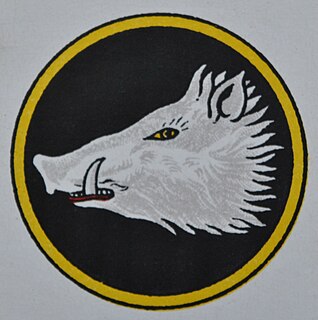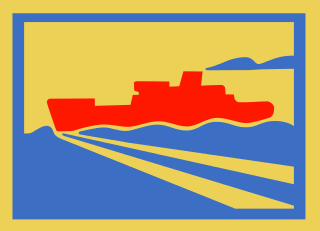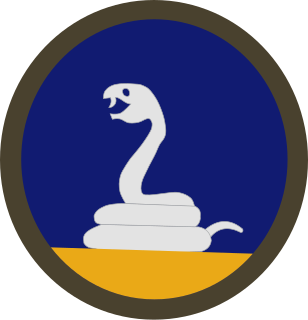
The 17th Airborne Division was an airborne infantry division of the United States Army during World War II, commanded by Major General William M. Miley.

The Fourth Army was a field army that formed part of the British Expeditionary Force during the First World War. The Fourth Army was formed on 5 February 1916 under the command of General Sir Henry Rawlinson to carry out the main British contribution to the Battle of the Somme.

The 55th Infantry Division was an infantry division of the British Army's Territorial Army (TA) that was formed in 1920 and existed through the Second World War, although it did not see combat. The division had originally been raised in 1908 as the West Lancashire Division, part of the British Army's Territorial Force (TF). It fought in the First World War, as the 55th Division, and demobilised following the fighting. In 1920, the 55th Division started to reform. It was stationed in the county of Lancashire throughout the 1920s and 1930s, and was under-funded and under-staffed. In the late 1930s, the division was reduced from three to two infantry brigades and gave up some artillery and other support units to become a motorised formation, the 55th Motor Division. This was part of a British Army doctrine change that was intended to increase battlefield mobility.

Fourteenth United States Army was a fictitious/military deception field army, under the command of John P. Lucas, developed as a part of Operation Quicksilver as a part of the fictitious First United States Army Group.

The 76th Infantry Division was an infantry division of the British Army, which was formed in November 1941 and served during the Second World War. It was created when the Norfolk County Division, initially raised in 1940 to defend the Norfolk coast from a potential German invasion, was redesignated. The division maintained the defensive duties that had been assigned to it, prior to it being renamed, until late 1942 when it became a training formation. It was then responsible for providing final tactical and field training to soldiers who had already passed their initial training. After five additional weeks of training, the soldiers were posted to fighting formations overseas. The formation was used as a source of reinforcements for the 21st Army Group, that was fighting in the Normandy campaign. After all available British troops had left the United Kingdom for France, the division was disbanded in September 1944.

The 77th Infantry Division of the British Army was formed in 1941, during the Second World War, from the re-organisation of the Devon and Cornwall County Division. During its existence the division changed roles several times. The division's initial role was coastal defence, protecting Devon. On 20 December 1942, it was converted into a training formation, known as a reserve division. In this capacity, the division provided final tactical and field training for the infantry that had already passed their initial training. After five additional weeks of training, the soldiers would be posted to fighting formations overseas. The division also had a tank brigade attached to provide training in armoured warfare.

First United States Army Group was a fictitious Allied Army Group in World War II prior to D-Day, part of Operation Quicksilver, created to deceive the Germans about where the Allies would land in France. To attract Axis attention, prominent US general George S. Patton was placed in command of the fabricated formation.

The 61st Infantry Division was an infantry division of the British Army, raised in 1939 as part of the expansion of the Territorial Army in response to the German occupation of Czechoslovakia. The division was created as a duplicate of the 48th Infantry Division, and was assigned to home defence duties.

The 80th Infantry (Reserve) Division was an infantry division of the British Army formed at the beginning of 1943, during the Second World War. For the twenty months that the division existed, it was a training formation. It was made responsible for providing final tactical and field training to soldiers who had already passed their initial training. After five additional weeks of training, the soldiers would be posted to fighting formations overseas. Notably, the division was used as a source of reinforcements for the 21st Army Group, which was fighting in Normandy. After all available troops left the United Kingdom for France, the division was disbanded.

The 11th Division, an infantry division of the United States Army, was activated twice during the First World War. During the Second World War the division was notionally reactivated as part of Fortitude South II.

The 17th Division of the United States Army was formed twice during the First World War. It was then recreated a third time as a Second World War 'phantom division' as part of Fortitude South II.
Operation Cockade was a series of deception operations designed to alleviate German pressure on Allied operations in Sicily and on the Soviets on the Eastern Front by feinting various attacks into Western Europe during World War II. The Allies hoped to use Cockade to force the Luftwaffe into a massive air battle with the Royal Air Force and U.S. Eighth Air Force that would give the Allies air superiority over Western Europe. Cockade involved three deception operations: Operation Starkey, Operation Wadham, and Operation Tindall. Operation Starkey was set to occur in early September, followed by Operation Tindall in mid September, and lastly Operation Wadham in late September 1943.

The 48th Armored Division was a division of the United States Army National Guard from September 1946 until 1968. Most of its units were part of the Florida Army National Guard and the Georgia Army National Guard. From 1946 to 1955 it was an infantry division. During World War II the denotation 48th Infantry Division was a 'phantom division' created for Operation Quicksilver, part of Operation Fortitude South II.

The US 55th Infantry Division was a 'phantom division' created in October 1943 to cover the departure of the US 5th Infantry Division from Iceland. An entirely notional force, its existence was reported to the Germans only through controlled agents as Iceland was too far from Europe to make use of radio deception.

The US 59th Infantry Division was a 'Phantom Division' created in May 1944 as part of Fortitude South II. to cover the deployment of the US 35th Infantry Division to Normandy.

The US 25th Armored Division was a 'phantom division' created in 1944 as part of Fortitude South II to replace the real US 5th Armored Division when that unit was deployed to Normandy.

The US XXXIII Corps was a 'Phantom Unit' created in 1944 as part of Fortitude South II.
The US XXXVII Corps was a 'Phantom Unit' created in 1944 as part of Fortitude South II, a military deception by the Allied nations during the build-up to the 1944 Normandy landings.

The United States Army created a large number of notional deception formations that were used in a number of World War II deception operations. The most notable fictional US formation was the First U.S. Army Group (FUSAG); this field army was originally intended as the main invasion force for the Invasion of Normandy, however that was renamed to the 12th Army Group. FUSAG remained in existence on paper and was used during Operation Fortitude South to divert Axis attention to the Pas de Calais area.

















